Geochronological, Geochemical and Pb Isotope Inferences for Genesis of Wulandele Porphyry Molybdenum Deposit, Inner Mongolia, Northeast China
Abstract
:1. Introduction
2. Geological Framework
2.1. Regional Geology
2.2. Ore Deposit Geology
2.2.1. Host Rocks
2.2.2. Ore Bodies
2.2.3. Ore Characteristics
2.3. Sampling
3. Analytical Methods
3.1. Zircon U-Pb Dating
3.2. Whole-Rock Major and Trace Elements
3.3. Pb Isotopes
4. Results
4.1. LA-ICP-MS Zircon U-Pb Age
4.2. Major and Trace Elements
4.3. Pb Isotope
5. Discussion
5.1. Timing of Granitoids from WLDL
5.2. Petrogenesis and Magma Source
5.3. Implication for Tectonic Setting and Porphyry Mo Mineralization
6. Conclusions
- U-Pb zircon data indicate that the quartz diorite and monzonitic granite crystallized at 282.5 ± 2.4 Ma (N = 23, MSWD = 0.14) and 135.4 ± 2.1 Ma (N = 18, MSWD = 1.7), respectively. These ages agree with geological observations that Permian granitoids (quartz diorite and granodiorite) are the host rocks of the Wulandele Mo deposit, while Cretaceous granite is the causative intrusion.
- Geochemical and isotopic data reveal that the high-K calc-alkaline Permian granitoids, classified as I-type intrusions, underwent extensive fractional crystallization in a continental arc environment. In contrast, the Cretaceous monzonitic granite, characterized as A-type, resulted from partial melting of the crust within an intraplate tectonic setting.
- Distinct from the majority of classical porphyry deposits, which are primarily associated with I-type granitoids, the Wulandele porphyry Mo deposit stands out as a product of an intraplate Cretaceous A-type magmatic event. The widespread presence of A-type intrusions in the GXR region implies that A-type granite-related porphyry Mo deposits should be considered as important targets for future exploration.
Author Contributions
Funding
Data Availability Statement
Acknowledgments
Conflicts of Interest
Appendix A
| Sample | WL-6 | WL-7 | WL-9 | WL-20 | WL-29 | WL-32 | WL-33 | WL-14 | WL-15 | WL-23 | WL-24 |
|---|---|---|---|---|---|---|---|---|---|---|---|
| Lithology | Quartz Diorite | Granodiorite | |||||||||
| SiO2 | 46.04 | 50 | 53.97 | 49.87 | 46.65 | 47.47 | 48.77 | 64.61 | 66.12 | 64.21 | 62.14 |
| Al2O3 | 13.61 | 13.88 | 15.73 | 14.57 | 12.84 | 14.32 | 14.7 | 16.25 | 15.65 | 15.86 | 15.03 |
| Fe2O3 | 4.59 | 5.1 | 3.38 | 3.25 | 4.44 | 4.3 | 3.55 | 2.04 | 1.68 | 1.94 | 1.36 |
| FeO | 9.56 | 8.32 | 6.58 | 8.79 | 9.94 | 8.91 | 8.79 | 3.24 | 3.21 | 4.02 | 3.32 |
| MgO | 5.93 | 4.64 | 4.36 | 5.03 | 5.85 | 5.35 | 4.5 | 1.56 | 1.46 | 1.78 | 1.38 |
| CaO | 9.39 | 7.65 | 6.7 | 7.98 | 9.01 | 9.15 | 6.47 | 2.94 | 2.81 | 3.26 | 2.57 |
| Na2O | 2.53 | 2.88 | 3.23 | 3.48 | 2.72 | 2.94 | 3.02 | 3.25 | 3.42 | 3.06 | 2.8 |
| K2O | 1.21 | 1.85 | 2.16 | 1.3 | 1.3 | 1.34 | 1.54 | 4.11 | 3.73 | 3.58 | 4.36 |
| MnO | 0.21 | 0.2 | 0.16 | 0.2 | 0.23 | 0.24 | 0.24 | 0.09 | 0.12 | 0.11 | 0.1 |
| P2O5 | 2.25 | 1.59 | 0.84 | 1.69 | 1.93 | 1.99 | 1.93 | 0.32 | 0.34 | 0.34 | 0.27 |
| TiO2 | 3.99 | 3.17 | 1.85 | 3.24 | 4.49 | 3.52 | 3.37 | 0.78 | 0.73 | 0.9 | 0.7 |
| LOI | 0.4 | 0.45 | 0.78 | 0.41 | 0.37 | 0.21 | 2.84 | 0.62 | 0.59 | 0.77 | 5.89 |
| Total | 99.72 | 99.73 | 99.75 | 99.79 | 99.8 | 99.73 | 99.72 | 99.81 | 99.85 | 99.83 | 99.94 |
| σ | 4.22 | 3.08 | 2.58 | 3.23 | 4.2 | 3.94 | 3.02 | 2.49 | 2.2 | 2.06 | 2.52 |
| DI | 30.93 | 40.99 | 47.18 | 40.03 | 33.37 | 34.81 | 42.36 | 73 | 74.42 | 69.51 | 74.23 |
| A/CNK | 0.6 | 0.67 | 0.79 | 0.67 | 0.58 | 0.63 | 0.8 | 1.07 | 1.06 | 1.07 | 1.07 |
| A/NK | 3.64 | 2.94 | 2.92 | 3.05 | 3.19 | 3.35 | 3.23 | 2.21 | 2.19 | 2.39 | 2.1 |
| Rb | 89 | 81 | 92 | 50 | 79 | 73 | 189 | 169 | 262 | 149 | 193 |
| Ba | 192 | 357 | 404 | 299 | 262 | 266 | 149 | 988 | 928 | 896 | 1025 |
| Th | 30.8 | 16.5 | 12.6 | 13.8 | 18 | 25.3 | 11.9 | 9.4 | 14 | 19.8 | 17.2 |
| U | 1.1 | 1.9 | 2.2 | 1.7 | 1.6 | 1.9 | 3 | 4.3 | 4.1 | 2.7 | 3.5 |
| Nb | 12.2 | 19.1 | 18.6 | 12.7 | 15.8 | 15.3 | 26.4 | 21.4 | 21.6 | 22.9 | 21.9 |
| Ta | 0.92 | 1.36 | 1.18 | 0.96 | 1.11 | 1.07 | 1.08 | 1.44 | 1.34 | 1.41 | 1.49 |
| K | 10,045 | 15,358 | 17,931 | 10,792 | 10,792 | 11,124 | 12,784 | 34,119 | 30,965 | 29,719 | 36,195 |
| Pb | 8.1 | 10.1 | 13.8 | 9.1 | 7.4 | 7.9 | 8.7 | 25 | 22 | 21.9 | 26 |
| Sr | 446 | 366 | 415 | 444 | 359 | 494 | 391 | 244 | 256 | 269 | 257 |
| P | 9819 | 6939 | 3666 | 7375 | 8423 | 8685 | 8423 | 1397 | 1484 | 1484 | 1178 |
| Zr | 145 | 203 | 295 | 214 | 206 | 144 | 169 | 383 | 458 | 487 | 430 |
| Hf | 8.2 | 12.6 | 13.7 | 12.8 | 11.4 | 8 | 9.9 | 17.2 | 18 | 18.9 | 19.8 |
| Sc | 33.6 | 34.4 | 26.9 | 26.3 | 32.4 | 35.2 | 31.1 | 14.7 | 15 | 17 | 15.4 |
| Ti | 23,920 | 19,004 | 11,091 | 19,424 | 26,918 | 21,103 | 20,203 | 4676 | 4376 | 5396 | 4197 |
| Y | 57.27 | 66.6 | 46.98 | 54.2 | 62.57 | 60 | 70.17 | 49.36 | 44.87 | 54.96 | 50.93 |
| V | 499 | 341 | 221 | 348 | 473 | 362 | 297 | 65 | 64 | 73 | 60 |
| Cr | 2.5 | 2.6 | 24.3 | 3.8 | 3.4 | 2.5 | 2.5 | 18.2 | 17.8 | 22 | 15.2 |
| Co | 52.8 | 37.5 | 30.6 | 39.5 | 51.9 | 43.2 | 30.5 | 9 | 8.5 | 9.8 | 8.6 |
| Ni | 15.3 | 12.1 | 20.7 | 11.4 | 17.8 | 10.3 | 7.2 | 11.2 | 10.8 | 12.8 | 11.1 |
| La | 50 | 57 | 43 | 46 | 51 | 51 | 60 | 33 | 54 | 51 | 47 |
| Ce | 119 | 138 | 98 | 109 | 127 | 124 | 146 | 67 | 112 | 107 | 94 |
| Pr | 17.5 | 19.2 | 13 | 15.5 | 18.2 | 17.7 | 19.9 | 8.8 | 13.8 | 13.4 | 12.2 |
| Nd | 83 | 86 | 57 | 71 | 84 | 83 | 91 | 38 | 55 | 56 | 49 |
| Sm | 17.2 | 17.6 | 11.7 | 14.7 | 17.8 | 17.3 | 18.4 | 8.5 | 10.3 | 11.7 | 10.3 |
| Eu | 3.5 | 3.58 | 2.43 | 3.25 | 3.48 | 3.7 | 3.52 | 2.39 | 2.32 | 2.52 | 2.36 |
| Gd | 14.5 | 15.42 | 10.33 | 12.76 | 15.29 | 15.04 | 15.83 | 8.15 | 9.05 | 10.43 | 9.21 |
| Tb | 2.18 | 2.34 | 1.62 | 1.92 | 2.26 | 2.24 | 2.37 | 1.44 | 1.43 | 1.72 | 1.54 |
| Dy | 11.25 | 12.66 | 8.94 | 10.33 | 11.92 | 11.49 | 12.55 | 8.38 | 7.92 | 9.87 | 8.93 |
| Ho | 2.04 | 2.33 | 1.67 | 1.89 | 2.19 | 2.1 | 2.34 | 1.64 | 1.52 | 1.91 | 1.71 |
| Er | 5.38 | 6.37 | 4.51 | 5.08 | 5.77 | 5.52 | 6.22 | 4.74 | 4.28 | 5.25 | 4.79 |
| Tm | 0.76 | 0.94 | 0.7 | 0.72 | 0.81 | 0.78 | 0.91 | 0.78 | 0.67 | 0.81 | 0.77 |
| Yb | 4.46 | 5.59 | 4.31 | 4.35 | 4.91 | 4.69 | 5.46 | 4.79 | 4.09 | 5.03 | 4.74 |
| Lu | 0.64 | 0.83 | 0.64 | 0.62 | 0.74 | 0.69 | 0.8 | 0.71 | 0.61 | 0.76 | 0.71 |
| ΣREE | 331.28 | 368.65 | 257.44 | 297.02 | 344.66 | 339.73 | 384.91 | 187.27 | 277.8 | 277.55 | 247.02 |
| LREE/HREE | 7.04 | 6.93 | 6.87 | 6.89 | 6.85 | 6.99 | 7.28 | 5.11 | 8.4 | 6.76 | 6.62 |
| LaN/YbN | 8.08 | 7.33 | 7.15 | 7.54 | 7.44 | 7.8 | 7.91 | 4.88 | 9.54 | 7.22 | 7.09 |
| δEu | 0.66 | 0.65 | 0.66 | 0.71 | 0.63 | 0.69 | 0.61 | 0.86 | 0.72 | 0.68 | 0.73 |
| SiO2 | 65.67 | 66.17 | 68.25 | 76.02 | 75.13 | 73.93 | 72.92 | 74.26 | 72.85 | 79.78 | 76.65 |
| Al2O3 | 15.74 | 15.59 | 15.01 | 12.99 | 13.73 | 13.9 | 14.55 | 14.1 | 14.38 | 11.8 | 13.13 |
| Fe2O3 | 1.56 | 1.41 | 1.4 | 0.43 | 0.46 | 0.63 | 0.52 | 0.51 | 0.65 | 0.11 | 0.29 |
| FeO | 3.49 | 3.44 | 2.73 | 0.74 | 0.39 | 0.65 | 0.85 | 0.72 | 0.82 | 0.16 | 0.27 |
| MgO | 1.45 | 1.43 | 1.26 | 0.32 | 0.19 | 0.33 | 0.37 | 0.2 | 0.39 | 0.12 | 0.1 |
| CaO | 2.64 | 2.56 | 2.3 | 0.93 | 0.73 | 1 | 1 | 1.01 | 1.18 | 0.22 | 0.59 |
| Na2O | 3.14 | 2.92 | 3.04 | 3.18 | 3.77 | 3.58 | 3.65 | 4.1 | 3.61 | 2.31 | 3.8 |
| K2O | 4.35 | 4.6 | 4.28 | 4.54 | 4.71 | 4.48 | 4.74 | 4.07 | 4.81 | 3.95 | 4.44 |
| MnO | 0.1 | 0.09 | 0.09 | 0.04 | 0.03 | 0.04 | 0.04 | 0.03 | 0.05 | 0.01 | 0.02 |
| P2O5 | 0.26 | 0.26 | 0.22 | 0.12 | 0.05 | 0.12 | 0.1 | 0.13 | 0.12 | 0.11 | 0.04 |
| TiO2 | 0.69 | 0.72 | 0.59 | 0.19 | 0.11 | 0.19 | 0.2 | 0.19 | 0.2 | 0.07 | 0.08 |
| LOI | 0.74 | 0.7 | 0.69 | 0.47 | 0.51 | 1.06 | 0.88 | 0.52 | 0.84 | 1.27 | 0.53 |
| Total | 99.82 | 99.88 | 99.86 | 99.97 | 99.83 | 99.9 | 99.83 | 99.85 | 99.88 | 99.93 | 99.94 |
| σ | 2.46 | 2.43 | 2.11 | 1.8 | 2.24 | 2.09 | 2.35 | 2.13 | 2.37 | 1.06 | 2.01 |
| DI | 74.55 | 75.11 | 78.12 | 91.82 | 93.66 | 91.15 | 90.5 | 91.78 | 90.07 | 95 | 95.08 |
| A/CNK | 1.07 | 1.08 | 1.09 | 1.1 | 1.09 | 1.11 | 1.12 | 1.09 | 1.08 | 1.39 | 1.08 |
| A/NK | 2.1 | 2.07 | 2.05 | 1.68 | 1.62 | 1.73 | 1.73 | 1.72 | 1.71 | 1.89 | 1.59 |
| Rb | 163 | 172 | 211 | 336 | 408 | 422 | 400 | 303 | 396 | 297 | 331 |
| Ba | 1027 | 988 | 824 | 279 | 174 | 443 | 539 | 198 | 544 | 52 | 35 |
| Th | 31.3 | 20.8 | 21.2 | 10.8 | 12.7 | 18.5 | 20.3 | 16.5 | 26 | 5.3 | 11 |
| U | 2.3 | 4.3 | 5.1 | 11.6 | 18.9 | 9.8 | 17.8 | 7.3 | 7.7 | 19.8 | 14.9 |
| Nb | 20.3 | 19.9 | 18.8 | 15.6 | 24.5 | 15.7 | 17.8 | 26.6 | 14.6 | 35.4 | 19.7 |
| Ta | 1.25 | 1.22 | 1.7 | 2.56 | 4.38 | 1.69 | 2.17 | 4.03 | 1.53 | 7.19 | 3.36 |
| K | 36,112 | 38,187 | 35,530 | 37,689 | 39,100 | 37,191 | 39,349 | 33,787 | 39,930 | 32,791 | 36,859 |
| Pb | 25.7 | 26.5 | 24.4 | 25.9 | 27.1 | 29.7 | 31.1 | 25.7 | 27 | 29.3 | 32.2 |
| Sr | 243 | 235 | 214 | 97 | 62 | 134 | 122 | 93 | 174 | 21 | 25 |
| P | 1135 | 1135 | 960 | 524 | 218 | 524 | 436 | 567 | 524 | 480 | 175 |
| Zr | 439 | 378 | 363 | 119 | 84 | 146 | 147 | 136 | 170 | 50 | 45 |
| Hf | 18.2 | 15.1 | 13.5 | 4.7 | 4.1 | 4.6 | 4.5 | 5.6 | 4.9 | 3.5 | 2.6 |
| Sc | 16.2 | 11.2 | 12.1 | 3 | 3.6 | 2.6 | 3.7 | 2.1 | 2.3 | 3.6 | 2.5 |
| Ti | 4137 | 4316 | 3537 | 1139 | 659 | 1139 | 1199 | 1139 | 1199 | 420 | 480 |
| Y | 52.83 | 39.86 | 35.03 | 12.45 | 19.54 | 11.62 | 13.29 | 20.2 | 10.1 | 26.76 | 16.17 |
| V | 67 | 67 | 55 | 15 | 10 | 17 | 17 | 17 | 17 | 9 | 7 |
| Cr | 15.1 | 15.8 | 11.7 | 2.1 | 3.3 | 2.9 | 2.5 | 2.9 | 2.5 | 2.5 | 4.5 |
| Co | 8.9 | 8.6 | 7.6 | 1.5 | 0.7 | 1.8 | 1.3 | 1.1 | 1.8 | 0.2 | 0.5 |
| Ni | 11.3 | 11.2 | 10.6 | 2.6 | 2.3 | 2.7 | 3 | 2.5 | 3 | 2.1 | 2.3 |
| La | 90 | 51 | 63 | 22 | 21 | 31 | 33 | 38 | 37 | 11 | 12 |
| Ce | 210 | 110 | 113 | 44 | 41 | 56 | 58 | 76 | 64 | 27 | 29 |
| Pr | 22.8 | 13.7 | 13.6 | 5.3 | 5 | 6.5 | 6.8 | 9 | 7.3 | 3.4 | 3.8 |
| Nd | 87 | 54 | 53 | 20 | 18 | 24 | 24 | 34 | 26 | 13 | 15 |
| Sm | 15 | 9.9 | 9.9 | 3.8 | 4.2 | 4.2 | 4.2 | 6.8 | 4.3 | 3.7 | 4 |
| Eu | 2.5 | 2.18 | 1.91 | 0.48 | 0.31 | 0.56 | 0.6 | 0.49 | 0.63 | 0.13 | 0.22 |
| Gd | 12.22 | 8.34 | 8.17 | 2.88 | 3.39 | 3.18 | 3.19 | 4.98 | 3.17 | 3.18 | 3.07 |
| Tb | 1.87 | 1.3 | 1.24 | 0.43 | 0.6 | 0.44 | 0.46 | 0.73 | 0.43 | 0.63 | 0.52 |
| Dy | 9.64 | 7.05 | 6.68 | 2.05 | 3.25 | 2.01 | 2.25 | 3.69 | 1.88 | 3.8 | 2.85 |
| Ho | 1.78 | 1.33 | 1.22 | 0.36 | 0.58 | 0.35 | 0.38 | 0.65 | 0.32 | 0.71 | 0.5 |
| Er | 5.13 | 3.73 | 3.28 | 1.02 | 1.74 | 0.95 | 1.06 | 1.86 | 0.86 | 2.14 | 1.46 |
| Tm | 0.78 | 0.59 | 0.45 | 0.17 | 0.3 | 0.15 | 0.17 | 0.32 | 0.13 | 0.39 | 0.25 |
| Yb | 4.85 | 3.78 | 2.62 | 1.17 | 2.08 | 0.99 | 1.07 | 2.25 | 0.82 | 2.73 | 1.64 |
| Lu | 0.73 | 0.58 | 0.37 | 0.17 | 0.31 | 0.15 | 0.16 | 0.33 | 0.11 | 0.41 | 0.25 |
| ΣREE | 464.58 | 267.48 | 277.21 | 103.65 | 102.13 | 130.3 | 134.53 | 179.44 | 147.27 | 72.29 | 74.52 |
| LREE/HREE | 11.56 | 9.02 | 10.53 | 11.59 | 7.34 | 14.85 | 14.39 | 11.12 | 18.1 | 4.17 | 6.07 |
| LaN/YbN | 13.37 | 9.68 | 17.18 | 13.64 | 7.16 | 22.55 | 21.76 | 12.2 | 32.7 | 2.85 | 5.25 |
| δEu | 0.55 | 0.71 | 0.63 | 0.42 | 0.25 | 0.45 | 0.48 | 0.25 | 0.49 | 0.11 | 0.18 |
| Spots | Pb | U | Th | U/Pb | Th /U | 207Pb/206Pb | 1σ | 207Pb/235U | 1σ | 206Pb/238U | 1σ | 206Pb/238U | 1σ | %U-Pb disc |
|---|---|---|---|---|---|---|---|---|---|---|---|---|---|---|
| WL20-01 | 9.4 | 151 | 201 | 16.06 | 1.34 | 0.0521 | 0.00156 | 0.3248 | 0.00979 | 0.04521 | 0.00069 | 285 | 7 | 0.35 |
| WL20-02 | 5.9 | 101 | 109 | 17.12 | 1.08 | 0.05196 | 0.00193 | 0.31553 | 0.01168 | 0.04404 | 0.0007 | 278 | 8 | 0.00 |
| WL20-03 | 17.4 | 300 | 314 | 17.24 | 1.05 | 0.05196 | 0.00123 | 0.32311 | 0.00785 | 0.0451 | 0.00066 | 284 | 7 | 0.00 |
| WL20-05 | 10.1 | 161 | 225 | 15.94 | 1.40 | 0.05212 | 0.00152 | 0.32364 | 0.00954 | 0.04504 | 0.00068 | 284 | 7 | 0.35 |
| WL20-06 | 7.4 | 116 | 169 | 15.68 | 1.46 | 0.05192 | 0.00176 | 0.32307 | 0.01095 | 0.04513 | 0.00071 | 285 | 7 | −0.35 |
| WL20-07 | 6.2 | 102 | 130 | 16.45 | 1.27 | 0.05201 | 0.00186 | 0.3217 | 0.0115 | 0.04486 | 0.0007 | 283 | 7 | 0.00 |
| WL20-08 | 18.4 | 297 | 398 | 16.14 | 1.34 | 0.05204 | 0.00125 | 0.32035 | 0.00787 | 0.04464 | 0.00066 | 282 | 7 | 0.00 |
| WL20-09 | 17.7 | 270 | 437 | 15.25 | 1.62 | 0.05193 | 0.00126 | 0.31951 | 0.00789 | 0.04462 | 0.00066 | 281 | 7 | 0.36 |
| WL20-10 | 11.9 | 189 | 261 | 15.88 | 1.39 | 0.05202 | 0.00139 | 0.32225 | 0.00875 | 0.04493 | 0.00067 | 283 | 7 | 0.35 |
| WL20-11 | 8.1 | 125 | 179 | 15.43 | 1.44 | 0.05336 | 0.00183 | 0.331 | 0.01137 | 0.04499 | 0.0007 | 284 | 8 | 2.11 |
| WL20-12 | 8.7 | 138 | 198 | 15.86 | 1.43 | 0.05186 | 0.00178 | 0.317 | 0.01086 | 0.04433 | 0.0007 | 280 | 7 | 0.00 |
| WL20-13 | 11.3 | 179 | 252 | 15.84 | 1.41 | 0.05204 | 0.00147 | 0.31963 | 0.00914 | 0.04454 | 0.00067 | 281 | 7 | 0.36 |
| WL20-14 | 8.3 | 138 | 164 | 16.63 | 1.19 | 0.05192 | 0.00164 | 0.32095 | 0.01016 | 0.04483 | 0.00069 | 283 | 7 | 0.00 |
| WL20-15 | 7.1 | 113 | 160 | 15.92 | 1.42 | 0.05204 | 0.00194 | 0.32193 | 0.01201 | 0.04487 | 0.00071 | 283 | 7 | 0.00 |
| WL20-16 | 11.5 | 180 | 260 | 15.65 | 1.44 | 0.05197 | 0.00138 | 0.32132 | 0.00864 | 0.04484 | 0.00068 | 283 | 7 | 0.00 |
| WL20-17 | 12.0 | 204 | 210 | 17.00 | 1.03 | 0.05204 | 0.00142 | 0.32332 | 0.00889 | 0.04506 | 0.00068 | 284 | 8 | 0.00 |
| WL20-18 | 9.1 | 147 | 190 | 16.15 | 1.30 | 0.05208 | 0.00156 | 0.32096 | 0.00966 | 0.0447 | 0.00068 | 282 | 7 | 0.35 |
| WL20-20 | 9.6 | 157 | 200 | 16.35 | 1.27 | 0.05198 | 0.00154 | 0.32139 | 0.00961 | 0.04485 | 0.00068 | 283 | 7 | 0.00 |
| WL20-21 | 15.0 | 233 | 340 | 15.53 | 1.46 | 0.05187 | 0.00127 | 0.32023 | 0.00803 | 0.04477 | 0.00066 | 282 | 7 | 0.00 |
| WL20-22 | 11.5 | 180 | 250 | 15.65 | 1.39 | 0.05198 | 0.00141 | 0.32134 | 0.0088 | 0.04483 | 0.00067 | 283 | 8 | 0.00 |
| WL20-23 | 11.3 | 177 | 254 | 15.66 | 1.43 | 0.05191 | 0.00144 | 0.3204 | 0.00898 | 0.04477 | 0.00068 | 282 | 8 | 0.00 |
| WL20-24 | 18.2 | 296 | 349 | 16.26 | 1.18 | 0.05204 | 0.00122 | 0.32626 | 0.00785 | 0.04547 | 0.00066 | 287 | 7 | 0.00 |
| WL20-25 | 15.3 | 228 | 378 | 14.90 | 1.66 | 0.05194 | 0.00129 | 0.3211 | 0.00812 | 0.04484 | 0.00066 | 283 | 7 | 0.00 |
| WL17-01 | 19.7 | 805 | 392 | 40.86 | 0.49 | 0.04882 | 0.00128 | 0.14618 | 0.00386 | 0.02171 | 0.00032 | 138 | 4 | 0.72 |
| WL17-03 | 2.4 | 87 | 87 | 36.25 | 1.00 | 0.05106 | 0.00417 | 0.14984 | 0.01214 | 0.02128 | 0.0004 | 136 | 6 | 1.45 |
| WL17-04 | 8.3 | 316 | 291 | 38.07 | 0.92 | 0.04834 | 0.00164 | 0.13989 | 0.00473 | 0.02099 | 0.00033 | 134 | 4 | −2.17 |
| WL17-05 | 21.0 | 814 | 534 | 38.76 | 0.66 | 0.04836 | 0.00127 | 0.14619 | 0.00387 | 0.02193 | 0.00033 | 140 | 4 | −2.16 |
| WL17-07 | 7.4 | 174 | 167 | 23.51 | 0.96 | 0.04605 | 0.00683 | 0.12979 | 0.0191 | 0.02044 | 0.00037 | 130 | 8 | −4.58 |
| WL17-08 | 9.6 | 292 | 286 | 30.42 | 0.98 | 0.04605 | 0.00202 | 0.12597 | 0.00521 | 0.01984 | 0.0003 | 127 | 3 | 5.36 |
| WL17-11 | 10.4 | 418 | 259 | 40.19 | 0.62 | 0.0488 | 0.00166 | 0.14284 | 0.00482 | 0.02123 | 0.00033 | 135 | 5 | 0.74 |
| WL17-14 | 38.1 | 1417 | 949 | 37.19 | 0.67 | 0.04683 | 0.0027 | 0.14013 | 0.00778 | 0.0217 | 0.00033 | 138 | 3 | −2.90 |
| WL17-15 | 88.5 | 3242 | 3060 | 36.63 | 0.94 | 0.05472 | 0.00141 | 0.1613 | 0.00416 | 0.02138 | 0.00032 | 136 | 4 | 8.82 |
| WL17-16 | 63.8 | 2497 | 1266 | 39.14 | 0.51 | 0.05247 | 0.00137 | 0.1598 | 0.00417 | 0.02209 | 0.00033 | 141 | 5 | 6.43 |
| WL17-17 | 33.3 | 1243 | 855 | 37.33 | 0.69 | 0.05158 | 0.00138 | 0.15828 | 0.00424 | 0.02226 | 0.00033 | 142 | 5 | 6.43 |
| WL17-18 | 164.8 | 6708 | 2869 | 40.70 | 0.43 | 0.0547 | 0.00295 | 0.1573 | 0.00811 | 0.02086 | 0.00033 | 133 | 2 | 2.59 |
| WL17-19 | 72.2 | 2966 | 1104 | 41.08 | 0.37 | 0.05292 | 0.00255 | 0.15622 | 0.00716 | 0.02141 | 0.00032 | 137 | 2 | 7.30 |
| WL17-21 | 8.2 | 255 | 369 | 31.10 | 1.44 | 0.0535 | 0.00694 | 0.14956 | 0.0192 | 0.02028 | 0.00038 | 129 | 2 | 2.98 |
| WL17-22 | 459.0 | 20670 | 4158 | 45.03 | 0.20 | 0.04848 | 0.00128 | 0.14155 | 0.00375 | 0.02118 | 0.00032 | 135 | 4 | −0.74 |
| WL17-23 | 229.4 | 10159 | 1563 | 44.29 | 0.15 | 0.05036 | 0.00189 | 0.14696 | 0.00507 | 0.02116 | 0.00032 | 135 | 2 | 2.92 |
| WL17-24 | 1.5 | 59 | 46 | 39.33 | 0.79 | 0.05153 | 0.00447 | 0.15283 | 0.01308 | 0.02151 | 0.00045 | 137 | 10 | 0.00 |
| WL17-25 | 1.5 | 54 | 52 | 36.00 | 0.96 | 0.0518 | 0.00636 | 0.15266 | 0.01858 | 0.02138 | 0.00047 | 136 | 9 | 2.19 |
| Sample no. | WL-7 | WL-9 | WL-11 | WL-14 | WL-26 | WL-27 | WL-30 | WL-34 | WL-42 |
|---|---|---|---|---|---|---|---|---|---|
| Lithology | Quartz Diorite | Granodiorite | Monzonitic Granite | ||||||
| U(ppm) | 1.9 | 2.2 | 1.7 | 4.3 | 2.3 | 4.3 | 7.3 | 19.8 | 14.9 |
| Th(ppm) | 16.5 | 12.6 | 13.8 | 9.4 | 31.3 | 20.8 | 16.5 | 5.3 | 11 |
| Pb(ppm) | 10.1 | 13.8 | 9.1 | 25 | 25.7 | 26.5 | 25.7 | 29.3 | 32.2 |
| Age/Ma | 283 | 283 | 283 | 283 | 283 | 283 | 135 | 135 | 135 |
| 206Pb/204Pb | 18.751 | 18.68 | 18.581 | 19.388 | 18.725 | 18.582 | 18.51 | 19.344 | 19.024 |
| 207Pb/204Pb | 15.55 | 15.563 | 15.552 | 15.597 | 15.57 | 15.55 | 15.507 | 15.572 | 15.56 |
| 208Pb/204Pb | 38.715 | 38.502 | 38.471 | 38.433 | 39.589 | 38.753 | 38.239 | 38.124 | 38.152 |
| (206Pb/204Pb)i | 18.211 | 18.224 | 18.048 | 18.892 | 18.465 | 18.117 | 18.129 | 18.429 | 18.400 |
| (207Pb/204Pb)i | 15.522 | 15.539 | 15.524 | 15.571 | 15.556 | 15.526 | 15.488 | 15.527 | 15.53 |
| (208Pb/204Pb)i | 37.193 | 37.654 | 37.066 | 38.081 | 38.441 | 38.023 | 37.958 | 38.044 | 38.001 |
References
- Sengör, A.M.C.; Natal’in, B.A.; Burtman, V.S. Evolution of the Altaid tectonic collage and Paleozoic crustal growth in Eurasia. Nature 1993, 364, 299–307. [Google Scholar] [CrossRef]
- Badarch, G.; Dickson, C.W.; Windley, B.F. A new terrane subdivision for Mongolia: Implications for the Phanerozoic crustal growth of Central Asia. J. Asian Earth Sci. 2002, 21, 87–110. [Google Scholar] [CrossRef]
- Windley, B.F.; Alexeiev, D.V.; Xiao, W.; Kröner, A.; Badarch, G. Tectonic models for accretion of the Central Asian Orogenic Belt. J. Geol. Soc. Lond. 2007, 164, 31–47. [Google Scholar] [CrossRef]
- Khain, E.V.; Bibikova, E.V.; Salnikova, E.B.; Kröner, A.; Gibsher, A.S.; Didenko, A.N.; Degtyarev, K.E.; Fedotova, A.A. The Palaeo-Asian Ocean in the Neoproterozoic and early Paleozoic: New geochronologic data and palaeotectonic reconstructions. Precambrian Res. 2003, 122, 329–358. [Google Scholar] [CrossRef]
- Kröner, A.; Windley, B.F.; Badarch, G.; Tomurtogoo, O.; Hegner, E.; Jahn, B.M.; Gruschka, S.; Khain, E.V.; Demoux, A.; Wingate, M.T.D. Accretionary growth and crust-formation in the Central Asian orogenic belt and comparison with the Arabian-Nubian shield. In 4-D Frame Work of Continental Crust; Memoirs Hatcher, R.D., Carlson, M.P., McBride, J.H., Martínez Catalán, J.R., Eds.; Geological Society of America: Boulder, CO, USA, 2007; Volume 200, pp. 181–209. [Google Scholar]
- Rytsk, E.Y.; Kovach, V.P.; Yarmolyuk, V.V.; Kovalenko, V.I. Structure and evolution of the continental crust in the Baikal Fold Region. Geotectonics 2007, 41, 440–464. [Google Scholar] [CrossRef]
- Tu, G.Z. A preliminary discussion on the Central Asian metallogenic belt. Sci. Geol. Sin. 1999, 34, 397–404. [Google Scholar]
- Xiao, W.J.; Windley, B.F.; Hao, J.; Zhai, M.G. Accretion leading to collision and the Permian Solonker suture; Inner Mongolia; China: Termination of the central Asian orogenic belt. Tectonics 2003, 22, 1069. [Google Scholar] [CrossRef]
- Xiao, W.J.; Kroner, A.; Windley, B. Geodynamic evolution of Central Asia in the Paleozoic and Mesozoic. Int. J. Earth Sci. 2009, 98, 1185–1188. [Google Scholar] [CrossRef]
- Wainwright, A.J.; Tosdal, R.M.; Wooden, J.L.; Mazdab, F.K.; Friedman, R.M. U–Pb (zircon) and geochemical constraints on the age; origin; and evolution of Paleozoic arc magmas in the Oyu Tolgoi porphyry Cu–Au district, southern Mongolia. Gondwana Res. 2011, 19, 764–787. [Google Scholar] [CrossRef]
- Shen, P.; Shen, Y.C.; Pan, H.D.; Li, X.H.; Dong, L.H.; Wang, J.B.; Zhu, H.P.; Dai, H.W.; Guan, W.N. Geochronology and isotope geochemistry of the Baogutu porphyry copper deposit in the west Junggar region, Xinjiang, China. J. Asian Earth Sci. 2012, 49, 99–115. [Google Scholar] [CrossRef]
- Zeng, Q.D.; Qin, K.Z.; Liu, J.M.; Li, G.M.; Zhai, M.G.; Chu, S.X.; Guo, Y.P. Porphyry molybdenum deposits in the Tianshan–Xingmeng orogenic belt; northern China. Int. J. Earth Sci. 2014, 104, 991–1023. [Google Scholar] [CrossRef]
- Goldfarb, R.J.; Taylor, R.D.; Collins, G.S.; Goryachev, N.A.; Orlandini, O.F. Phanerozoic continental growth and gold metallogeny of Asia. Gondwana Res. 2013, 25, 48–102. [Google Scholar] [CrossRef]
- Gao, J.; Klemd, R.; Zhu, M.T.; Wang, X.S.; Li, J.L.; Wan, B.; Xiao, W.J.; Zen, Q.D.; Shen, P.; Sun, J.G.; et al. Large-scale porphyry-type mineralization in the Central Asian metallogenic domain: A review. J. Asian Earth Sci. 2018, 165, 7–36. [Google Scholar] [CrossRef]
- Mao, J.W.; Pirajno, F.; Lehmann, B.; Luo, M.C.; Berzina, A. Distribution of porphyry deposits in the Eurasian continent and their corresponding tectonic settings. J. Asian Earth Sci. 2014, 79, 576–584. [Google Scholar] [CrossRef]
- Seltmann, R.; Mike Porter, T.; Pirajno, F. Geodynamics and metallogeny of the central Eurasian porphyry and related epithermal mineral systems: A review. J. Asian Earth Sci. 2014, 79, 810–841. [Google Scholar] [CrossRef]
- Liu, J.M.; Zhang, R.; Zhang, Q.Z. The regional metallogeny of Da Hinggan Ling, China. Earth Sci. Front. 2004, 11, 269–277, (In Chinese with English abstract). [Google Scholar]
- Han, C.M.; Xiao, W.J.; Zhao, G.C.; Su, B.X.; Ao, S.J.; Zhang, J.; Zhang, J.Y.; Wan, B.; Wang, Z.M. Tectonic implications of Re-Os dating of molybdenum deposits in the Tianshan–Xingmeng Orogenic Belt, Central Asia. Int. Geol. Rev. 2014, 56, 985–1006. [Google Scholar] [CrossRef]
- Zeng, Q.D.; Liu, J.M.; Chu, S.X.; Wang, Y.B.; Sun, Y.; Duan, X.X.; Zhou, L.L. Mesozoic molybdenum deposits in the East Xingmeng orogenic belt, northeast China: Characteristics and tectonic setting. Int. Geol. Rev. 2012, 54, 1843–1869. [Google Scholar] [CrossRef]
- Chen, Y.J.; Zhang, C.; Wang, P.; Pirajno, F.; Li, N. The Mo deposits of Northeast China: A powerful indicator of tectonic settings and associated evolutionary trends. Ore Geol. Rev. 2017, 81, 602–640. [Google Scholar] [CrossRef]
- Hu, X.L.; Ding, Z.J.; He, M.C.; Yao, S.Z.; Zhu, B.P.; Shen, J.; Chen, B. A porphyry-skarn metallogenic system in the Lesser Xing’an Range, NE China: Implications from U–Pb and Re–Os geochronology and Sr–Nd–Hf isotopes of the Luming Mo and Xulaojiugou Pb–Zn deposit. J. Asian Earth Sci. 2014, 90, 88–100. [Google Scholar] [CrossRef]
- Li, Z.Z.; Qin, K.Z.; Li, G.M.; Ishihara, S.; Jin, L.Y.; Song, G.X.; Meng, Z.J. Formation of the giant Chalukou porphyry Mo deposit in northern GXR, NE China: Partial melting of the juvenile lower crust in intra-plate extensional environment. Lithos 2014, 202–203, 138–156. [Google Scholar] [CrossRef]
- Nie, F.J.; Sun, Z.J.; Li, C.; Liu, Y.F.; Lu, K.P.; Zhang, K.; Liu, Y. Re–Os isotopic dating of molybdenite separates from Chalukou porphyry Mo polymetallic deposit in Heilongjiang Province. Min. Deposits 2011, 30, 828–836. [Google Scholar]
- Shao, J.; Yang, H.Z.; Jia, B.; Peng, M.S. Geological characteristics and ore-forming age of Luming Mo deposit in Heilongjiang Province. Min. Deposits 2012, 31, 1301–1310. [Google Scholar]
- Ju, N.; Zhang, D.; Zhang, G.B.; Zhang, S.; Ren, C.T.; Ren, Y.S.; Wang, H.; Wu, Y.; Liu, X.; Shi, L.; et al. Geology and mineralization of the Daheishan supergiant porphyry molybdenum deposit (1.65 Bt), Jilin, China: A review. China Geol. 2023, 6, 494–530. [Google Scholar] [CrossRef]
- Leng, C.B.; Zhang, X.C.; Huang, Z.L.; Huang, Q.Y.; Wang, S.X.; Ma, D.Y.; Luo, T.Y.; Li, C.; Li, W.B. Geology, Re-Os ages, sulfur and lead isotopes of the Diyanqinamu porphyry Mo deposit, Inner Mongolia, NE China. Econ. Geol. 2015, 110, 557–574. [Google Scholar] [CrossRef]
- Zeng, Q.D.; Liu, J.M.; Zhang, Z.L.; Chen, W.J.; Zhang, W.Q. Geology and geochronology of the Xilamulun molybdenum metallogenic belt in eastern Inner Mongolia, China. Int. J. Earth Sci. 2011, 100, 1791–1809. [Google Scholar] [CrossRef]
- Zhang, L.C.; Wu, H.Y.; Wan, B.; Chen, Z.G. Ages and geodynamic settings of Xilamulun Mo-Cu metallogenic belt in the northern part of the North China craton. Gondwana Res. 2009, 16, 243–254. [Google Scholar] [CrossRef]
- Nie, F.J.; Jiang, S.H. Geological setting and origin of Mo-W-Cu deposits in the Honggor-Shamai district, Inner Mongolia, North China. Resour. Geol. 2011, 61, 344–355. [Google Scholar] [CrossRef]
- Shao, J.D.; Tao, J.X.; Li, S.W.; Shang, H.S.; Wu, L.W.; Gong, Z.Z. The new progress in ore prospecting within the Daxing’anling mineralization belt, China. Geol. Bull. China 2009, 28, 955–962, (In Chinese with English abstract). [Google Scholar]
- Tao, J.X.; Wang, T.; Cheng, Z.H.; Luo, Z.Z.; Xu, L.Q.; Hao, X.Y.; Cui, L.W. The Re–Os isotopic dating of molybdenite from the Wulandele molybdenum–copper polymetallic deposit in Sonid Zuoqi of Inner Mongolia and its geological significance. Rock Miner. Anal. 2009, 28, 249–253. (In Chinese) [Google Scholar]
- Zhang, F.F.; Wang, Y.H.; Liu, J.J.; Wang, J.C. Ore genesis and hydrothermal evolution of the Wulandele Mo deposit, Inner Mongolia, Northeast China: Evidence from geology, fluid inclusions and H–O–S–Pb isotopes. Ore Geol. Rev. 2018, 93, 181–199. [Google Scholar] [CrossRef]
- Zhang, X.H.; Yao, C.L.; Lentz, D.R.; Qin, Y.; Wei, Y.W.; Zhao, F.S.; Yang, Z.J.; Liu, R.; Zhang, Z.F. Re-Os Geochronology, Whole-Rock and Radiogenic Isotope Geochemistry of the Wulandele Porphyry Molybdenum Deposit in Inner Mongolia, China, and Their Geological Significance. Minerals 2020, 10, 374. [Google Scholar] [CrossRef]
- Nie, F.J.; Jiang, S.H.; Zhang, Y.; Liu, Y.; Hu, P. Geological features and origin of porphyry copper deposits in China-Mongolia border region and its neighboring areas. Min. Deposits 2004, 23, 176–189. [Google Scholar]
- Porter, T.M. The geology; structure and mineralisation of the Oyu Tolgoi porphyry copper-gold-molybdenum deposits, Mongolia: A review. Geosci. Front. 2015, 6, 1–60. [Google Scholar] [CrossRef]
- Eggins, S.M.; Kinsley, L.P.J.; Shelley, J.M.M. Deposition elemental fractionation processes during atmospheric pressure laser sampling for analysis by ICP–MS. Appl. Surf. Sci. 1998, 127, 278–286. [Google Scholar] [CrossRef]
- Jackson, S.E.; Pearson, N.J.; Griffin, W.L.; Belousova, E.A. The application of laser ablation-inductively coupled plasma–mass spectrometry to in situ U–Pb zircon geochronology. Chem. Geol. 2004, 211, 47–69. [Google Scholar] [CrossRef]
- Wang, W.; Liu, S.W.; Bai, X.; Li, Q.G.; Yang, P.T.; Zhao, Y.; Zhang, S.H. and Guo, R.R. Geochemistry and zircon U–Pb–Hf isotopes of the late Paleoproterozoic Jianping diorite–monzonite–syenite suite of the North China Craton: Implications for petrogenesis and geodynamic setting. Lithos 2013, 162, 175–194. [Google Scholar] [CrossRef]
- Schaltegger, U.; Davies, J.H.F.L. Petrochronology of Zircon and Baddeleyite in Igneous Rocks: Reconstructing Magmatic Processes at High Temporal Resolution. Rev. Mineral. Geochem. 2017, 83, 297–328. [Google Scholar] [CrossRef]
- Fornelli, A.; Festa, V.; Micheletti, F.; Spiess, R.; Tursi, F. Building an Orogen: Review of U-Pb Zircon Ages from the Calabria–Peloritani Terrane to Constrain the Timing of the Southern Variscan Belt. Minerals 2020, 10, 944. [Google Scholar] [CrossRef]
- Corfu, F.; Hanchar, J.M.; Hoskin, P.W.; Kinny, P. Atlas of zircon textures. Rev. Mineral. Geochem. 2003, 53, 469–500. [Google Scholar] [CrossRef]
- Fornelli, A.; Piccarreta, G.; Micheletti, F. In situ U-Pb dating combined with SEM imaging on zircon–an analytical bond for effective geological reconstructions. In Geochronology–Methods and Case Studies; Mörner, N.A., Ed.; IntechOpen Limited: London, UK, 2014; pp. 109–139. [Google Scholar]
- Hoskin, P.W.O.; Schaltegger, U. The composition of zircon and igneous and metamorphic petrogenesis. Rev. Mineral. Geochem. 2003, 53, 27–62. [Google Scholar] [CrossRef]
- Middlemost, E.A.K. Naming materials in the magma/igneous rock system. Earth-Sci. Rev. 1994, 37, 215–224. [Google Scholar] [CrossRef]
- Peccerillo, A.; Taylor, S.R. Geochemistry of eocene calc-alkaline volcanic rocks from the Kastamonu area, Northern Turkey. Contrib. Mineral. Petrol. 1976, 58, 63–81. [Google Scholar] [CrossRef]
- Jahn, B.M.; Wu, F.Y.; Chen, B. Massive granitoid generation in Central Asia: Nd isotope evidence and implication for continental growth in the Phanerozoic. Episodes 2000, 23, 82–92. [Google Scholar] [CrossRef] [PubMed]
- Hong, D.W.; Wang, S.G.; Xie, X.L.; Zhang, J.S. Genesis of positive ε(Nd,t) granitoids in the Da Hinggan Mts.-Mongolia orogenic belt and growth continental crust. Earth Sci. Front. 2000, 7, 440–456, (In Chinese with English abstract). [Google Scholar]
- Hong, D.W.; Wang, S.G.; Han, B.F.; Jin, M.Y. The Permian alkaline granites in Central Inner Mongolia and their geodynamic significance. J. Southeast Asian Earth Sci. 1994, 10, 169–176. [Google Scholar]
- Hong, D.W.; Wang, S.G.; Han, B.F.; Jin, M.Y. Post-orogenic alkaline granites from China and comparisons with anorogenic alkaline granites elsewhere. J. Southeast Asian Earth Sci. 1996, 30, 13–27. [Google Scholar]
- Zhang, Y.Q.; Xu, L.Q.; Kang, X.L.; Bao, Y. Age dating of alkali granite in the Jingesitai area of Dongujimqin Banner; Inner Mongolia, and its significance. Geol. China 2009, 36, 988–992, (In Chinese with English abstract). [Google Scholar]
- Zhang, X.H.; Yuan, L.L.; Xue, F.H.; Yan, X.; Mao, Q. Early Permian A-type granites from central Inner Mongolia, North China: Magmatic tracer of post-collisional tectonics and oceanic crustal recycling. Gondwana Res. 2015, 28, 311–327. [Google Scholar] [CrossRef]
- Tong, Y.; Jahn, B.M.; Wang, T.; Hong, D.W.; Smith, E.I.; Sun, M.; Gao, J.F.; Yang, Q.D.; Huang, W. Permian alkaline granites in the Erenhot–Hegenshan belt, northern Inner Mongolia; China: Model of generation, time of emplacement and regional tectonic significance. J. Asian Earth Sci. 2015, 97, 320–336. [Google Scholar] [CrossRef]
- Zhang, J.H.; Gao, S.; Ge, W.C.; Wu, F.Y.; Yang, J.H.; Wilde, S.A.; Li, M. Geochronology of the Mesozoic volcanic rocks in the GXR, northeast China: Implications for subduction-induced delamination. Chem. Geol. 2010, 276, 144–165. [Google Scholar] [CrossRef]
- Wu, F.Y.; Sun, D.Y.; Ge, W.C.; Zhang, Y.B.; Grant, M.L.; Wilde, S.A.; Jahn, B.M. Geochronology of the Phanerozoic granitoids in northeastern China. J. Asian Earth Sci. 2011, 41, 1–30. [Google Scholar] [CrossRef]
- Xu, W.L.; Pei, F.P.; Wang, F.; Meng, E.; Ji, W.Q.; Yang, D.B.; Wang, W. Spatial-temporal relationships of Mesozoic volcanic rocks in NE China: Constraints on tectonic overprinting and transformations between multiple tectonic systems. J. Asian Earth Sci. 2013, 74, 167–193. [Google Scholar] [CrossRef]
- Wu, F.Y.; Sun, D.Y.; Li, H.M.; Jahn, B.M.; Wilde, S.A. A-type granites in NE China: Age and geochemical constraints on their petrogenesis. Chem. Geol. 2002, 187, 143–173. [Google Scholar] [CrossRef]
- Wu, F.Y.; Lin, J.Q.; Wilde, S.A.; Zhang, X.O.; Yang, J.H. Nature and significance of the Early Cretaceous giant igneous event in eastern China. Earth Planet. Sci. Lett. 2005, 233, 103–119. [Google Scholar] [CrossRef]
- Wang, F.; Zhou, X.H.; Zhang, L.C.; Ying, J.F.; Zhang, Y.T.; Wu, F.Y.; Zhu, R.X. Late Mesozoic volcanism in the GXR (NE China): Timing and implications for the dynamic setting of NE Asia. Earth Planet. Sci. Lett. 2006, 251, 179–198. [Google Scholar] [CrossRef]
- Yang, W.B.; Niu, H.C.; Cheng, L.R.; Shan, Q.; Li, N.B. Geochronology, geochemistry and geodynamic implications of the Late Mesozoic volcanic rocks in the southern Great Xing’an Mountains, NE China. J. Asian Earth Sci. 2015, 113, 454–470. [Google Scholar] [CrossRef]
- Whalen, J.B.; Currie, K.L.; Chappell, B.W. A-type granites: Geochemical characteristics, discrimination and petrogenesis. Contrib. Mineral. Petrol. 1987, 95, 407–419. [Google Scholar] [CrossRef]
- Watson, E.B.; Harrison, T.M. Zircon saturation revisited: Temperature and composition effects in a variety of crustal magma types. Earth Planet Sc. Lett. 1983, 64, 295–304. [Google Scholar] [CrossRef]
- Yang, X.M. Estimation of crystallization pressure of granite intrusions. Lithos 2017, 286, 324–329. [Google Scholar] [CrossRef]
- Eby, G.N. The A-type granitoids: A review of their occurrence and chemical characteristics and speculations on their petrogenesis. Lithos 1990, 26, 115–134. [Google Scholar] [CrossRef]
- Bernard, B.; Abla, A.S.; François, B.; Sandrine, F. Alkali-calcic and alkaline postorogenic (PO) granite magmatism: Petrologic constraints and geodynamic settings. Lithos 1998, 45, 45–70. [Google Scholar]
- Pearce, J.A. Role of sub-continental lithosphere in magma genesis at destructive plate margins. In Continental Basalts and Mantle Xenoliths; Hawkesworth, C.J., Norry, M.J., Eds.; Shiva Publishing Ltd.: Nantwich, Cheshire, 1983; pp. 230–249. [Google Scholar]
- Wilson, M. Igneous Petrogenesis; Kluwer Academic Publishers: Dordrecht, The Netherland, 1989; p. 466. [Google Scholar]
- Taylor, S.R.; McLennan, S.M. The Continental Crust: Its Composition and Evolution; Oxford Press: New York, NY, USA, 1985; p. 312. [Google Scholar]
- McDonough, W.F.; Sun, S.S. The composition of the Earth. Chem. Geol. 1995, 120, 223–253. [Google Scholar] [CrossRef]
- Zhou, Z.H.; Mao, J.W.; Lyckberg, P. Geochronology and isotopic geochemistry of the A-type granites from the Huanggang Sn–Fe deposit, southern Great Hinggan Range, NE China: Implication for their origin and tectonic setting. J. Asian Earth Sci. 2012, 49, 272–286. [Google Scholar] [CrossRef]
- Canals, A.; Cardellach, E. Ore lead and sulphur isotope pattern from the low temperature veins of the Catalonian Coastal Ranges (NE Spain). Miner. Deposita 1997, 32, 2343–2349. [Google Scholar] [CrossRef]
- Li, W.B.; Huang, Z.L.; Zhang, G. Sources of the ore metals of the Huize ore field in Yunnan province constraints from Pb; S; C; H; O and Sr isotope geochemistry. Acta Petrol. Sin. 2006, 22, 2567–2580, (In Chinese with English abstract). [Google Scholar]
- Shi, Y.R.; Liu, D.Y.; Zhang, Q.; Jian, P.; Zhang, F.Q.; Miao, L.C.; Shi, G.H.; Zhang, L.Q.; Tao, H. SHRIMP geochronology of dioritic-granitic intrusions in Sunidzuoqi area, Inner Mongolia. Acta Geol. Sin. 2004, 78, 789–799, (In Chinese with English abstract). [Google Scholar]
- Cui, F.H.; Zheng, C.Q.; Xu, X.C.; Yao, W.G.; Shi, L.; Xu, J.L. Late Carboniferous magmatic activities in the Quanshenglinchang Area, GXR: Constraints on the timing of amalgamation between Xing’an and Songnen massifs. Acta Geol. Sin. 2013, 87, 1247–1263, (In Chinese with English abstract). [Google Scholar]
- Chen, B.; Jahn, B.M.; Wilde, S.; Xu, B. Two contrasting Paleozoic magmatic belts in northern Inner Mongolia, China: Petrogenesis and tectonic implications. Tectonophysics 2000, 328, 157–182. [Google Scholar] [CrossRef]
- Shi, G.H.; Miao, L.C.; Zhang, F.Q.; Jian, P.; Fan, W.M.; Liu, D.Y. The age and its district tectonic implications on the Xilinhot A-type granites, Inner Mongolia. Chin. Sci. Bull. 2004, 4, 384–389, (In Chinese with English abstract). [Google Scholar]
- Han, J.; Zhou, J.B.; Wang, B.; Cao, J.L. The final collision of the CAOB: Constraint from the zircon U–Pb dating of the Linxi Formation, Inner Mongolia. Geosci. Front. 2015, 6, 211–225. [Google Scholar] [CrossRef]
- Miao, L.C.; Fan, W.M.; Liu, D.Y.; Zhang, F.Q.; Shi, Y.R.; Guo, F. Geochronology and geochemistry of the Hegenshan ophiolitic complex: Implications for late stage tectonic evolution of the Inner Mongolia-Daxinganling Orogenic Belt. J. Asian Earth Sci. 2008, 32, 348–370. [Google Scholar] [CrossRef]
- Nozaka, T.; Liu, Y. Petrology of the Hegenshan ophiolite and its implication for the tectonic evolution of northern China. Earth Planet. Sci. Lett. 2002, 202, 89–104. [Google Scholar] [CrossRef]
- Wilde, S.A. Final amalgamation of the Central Asian Orogenic Belt in NE China: Paleo–Asian Ocean closure versus Paleo–Pacific plate subduction—A review of the evidence. Tectonophysics 2015, 662, 345–362. [Google Scholar] [CrossRef]
- Li, D.P.; Jin, Y.; Hou, K.J.; Chen, Y.L.; Lu, Z. Late Paleozoic final closure of the Paleo-Asian Ocean in the eastern part of the Xing-Meng Orogenic Belt: Constrains from Carboniferous-Permian (meta-) sedimentary strata and (meta-) igneous rocks. Tectonophysics 2015, 665, 251–262. [Google Scholar] [CrossRef]
- Pearce, J.A.; Harris, N.B.W.; Tindle, A.G. Trace element discrimination diagrams for the tectonic interpretation of granitic rocks. J. Petrol. 1984, 25, 956–983. [Google Scholar] [CrossRef]
- Whalen, J.B.; Hildebrand, R.S. Trace element discrimination of arc, slab failure, and A-type granitic rocks. Lithos 2019, 348, 105179. [Google Scholar] [CrossRef]
- Xu, L.Q.; Chen, Z.Y.; Chen, Z.H.; Zhang, T.; Zhang, Y.Q. SHRIMP dating of medium-coarse-grained granite in Chaobuleng iron deposit, Dong Ujimqin Banner, Inner Mongolia. Miner. Deposits 2010, 29, 317–320, (In Chinese with English abstract). [Google Scholar]
- Yang, Z.H. Metallogenic Characteristics and Metallogenic Mechanism in the Wurinitu W-Mo deposit in Inner Mongolia, China. Master’s Thesis, China University of Geosciences, Beijing, China, 2013. [Google Scholar]
- Zeng, Q.D.; Liu, J.M.; Qin, F.; Zhang, Z.L. Geochronology of the Xiaodonggou porphyry Mo deposit in northern margin of North China Craton. Resour. Geol. 2010, 60, 192–202. [Google Scholar] [CrossRef]
- Selby, D.; Nesbitt, B.E.; Muehlenbachs, K.; Prochaska, W. Hydrothermal alteration and fluid chemistry of the Endako porphyry molybdenum deposit, British Columbia. Econ. Geol. 2000, 95, 183–202. [Google Scholar] [CrossRef]
- Lawley, C.J.M.; Richards, J.P.; Anderson, R.G.; Creaser, R.A.; Heaman, L.M. Geochronology and geochemistry of the MAX porphyry Mo deposit and its relationship to Pb-Zn-Ag mineralization, Kootenay arc, southeastern British Columbia, Canada. Econ. Geol. 2010, 105, 1113–1142. [Google Scholar] [CrossRef]
- White, W.H.; Bookstrom, A.A.; Kamilli, R.J.; Ganster, M.W.; Smith, R.; Ranta, D.E.; Steininger, R.C. Character and origin of Climax-type molybdenum deposits. Econ. Geol. 1981, 75, 270–316. [Google Scholar]
- Ludington, S.; Plumlee, G.S. Climax-type porphyry molybdenum deposits. In US Geological Survey Open-File Report; U.S. Geological Survey: Reston, VA, USA, 2009; Volume 1215. [Google Scholar]
- Keith, J.D.; Christiansen, E.H.; Carten, R.B. The genesis of giant porphyry molybdenum deposits. In Giant Ore Deposits; Special Publications of the Society of Economic Geologists; Whiting, B.H., Hodgson, C.J., Mason, R., Eds.; 1993; pp. 285–317. Available online: https://pubs.geoscienceworld.org/segweb/books/book/1226/chapter-abstract/107024848/The-Genesis-of-Giant-Porphyry-Molybdenum-Deposits?redirectedFrom=fulltext (accessed on 21 May 2024).
- Ye, H.S.; Mao, J.W.; Li, Y.F.; Guo, B.J.; Zhang, C.Q.; Liu, J.; Yan, Q.R.; Liu, G.Y. SHRIMP Zircon U-Pb and Molybdenite Re-Os Datings of the Superlarge Donggou Porphyry Molybdenum Deposit in the East Qinling, China, and Its Geological Implications. Acta Geol. Sin. 2008, 82, 134–145. [Google Scholar]
- Blevin, P.L. Redox and compositional parameters for interpreting the granitoid metallogeny of eastern Australia: Implications for gold-rich ore systems. Resour. Geol. 2004, 54, 241–252. [Google Scholar] [CrossRef]
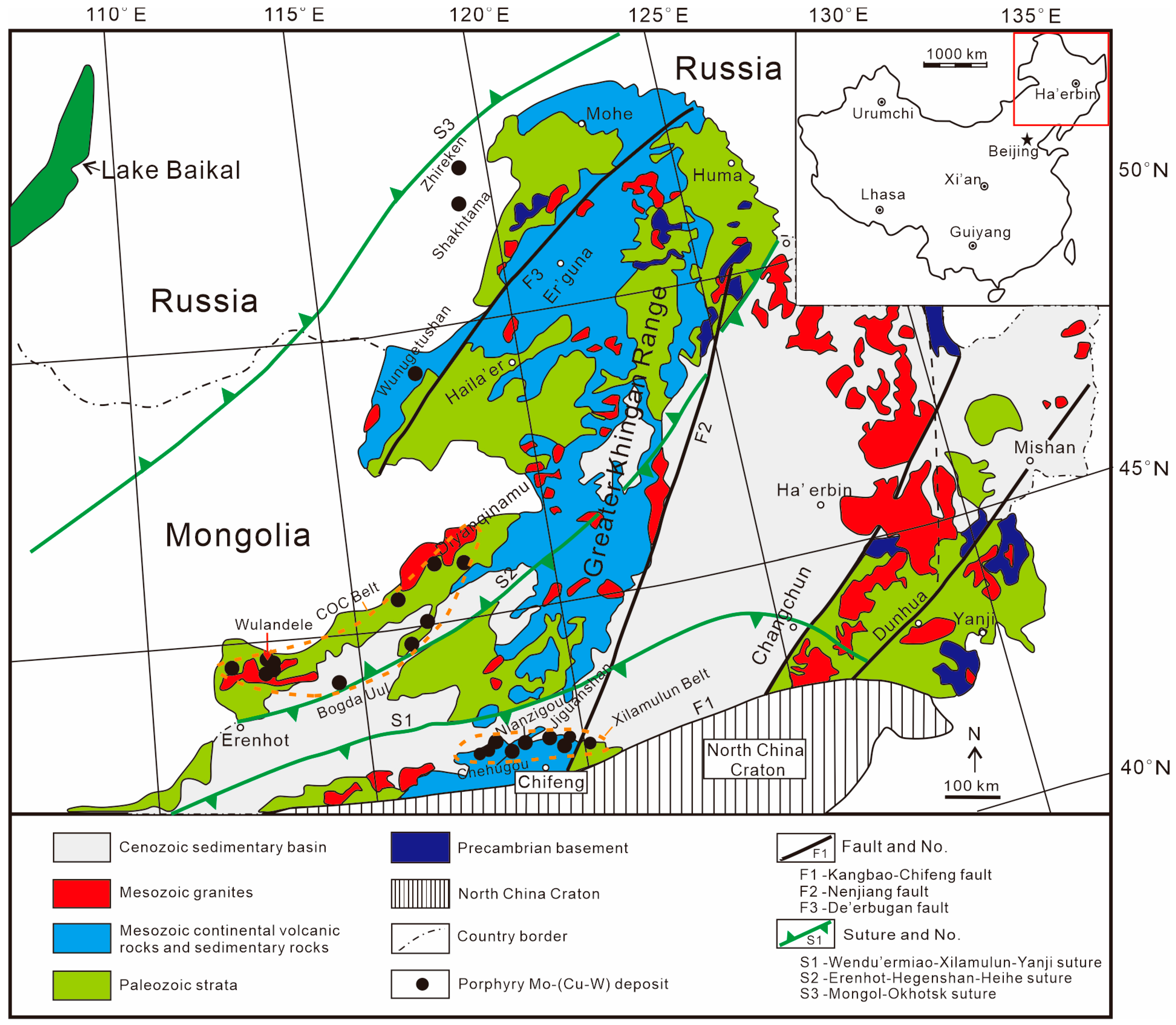
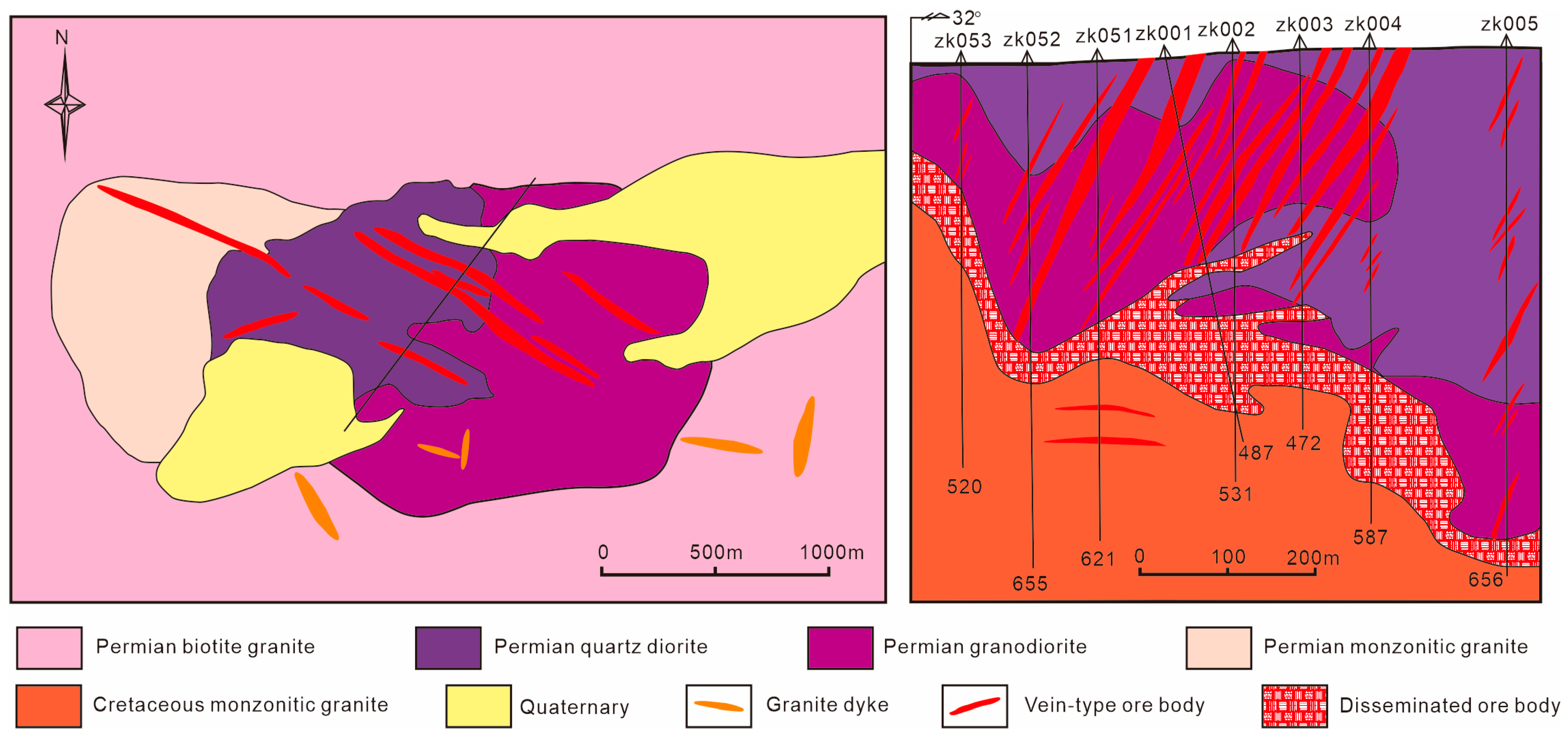
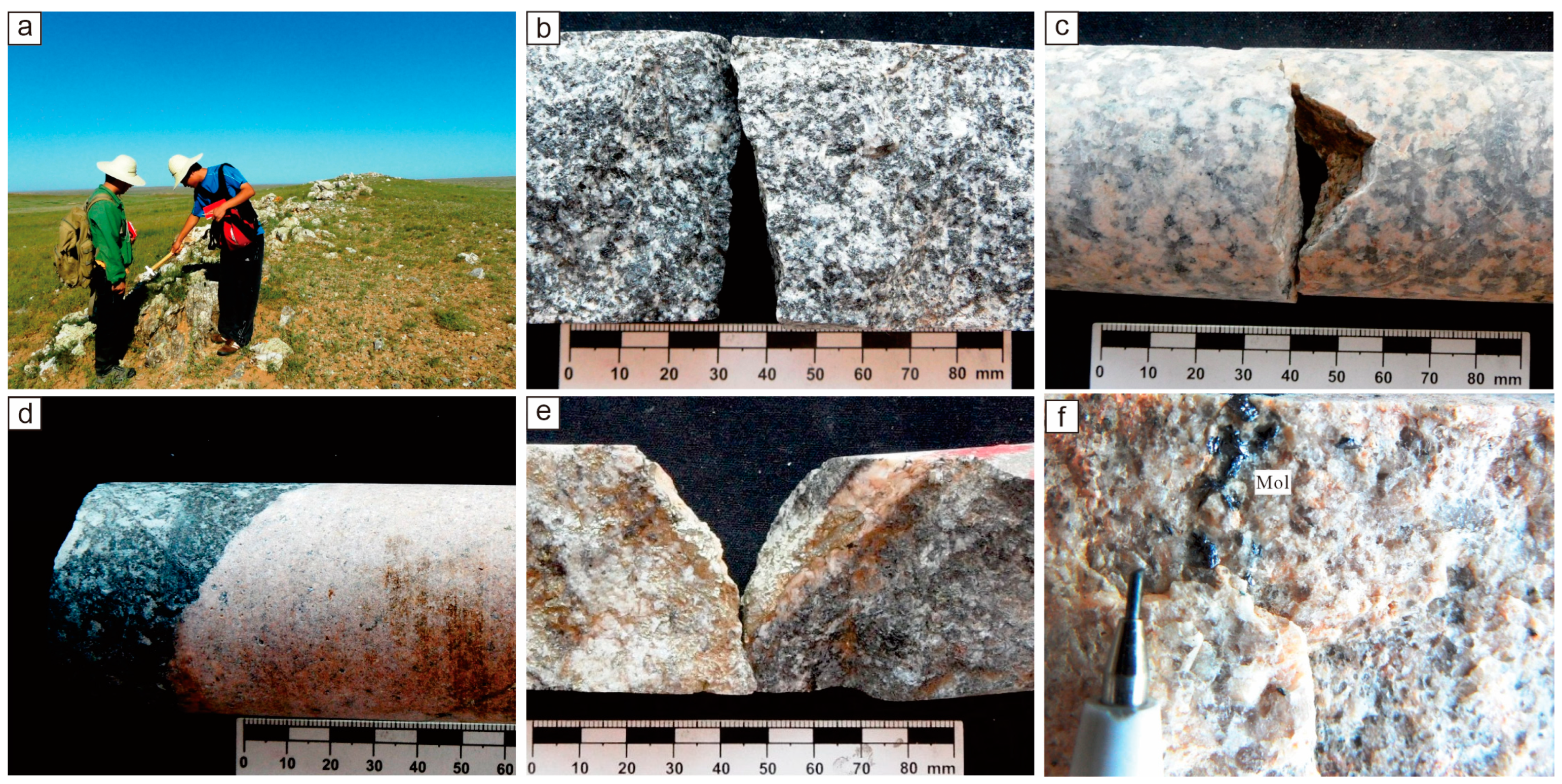
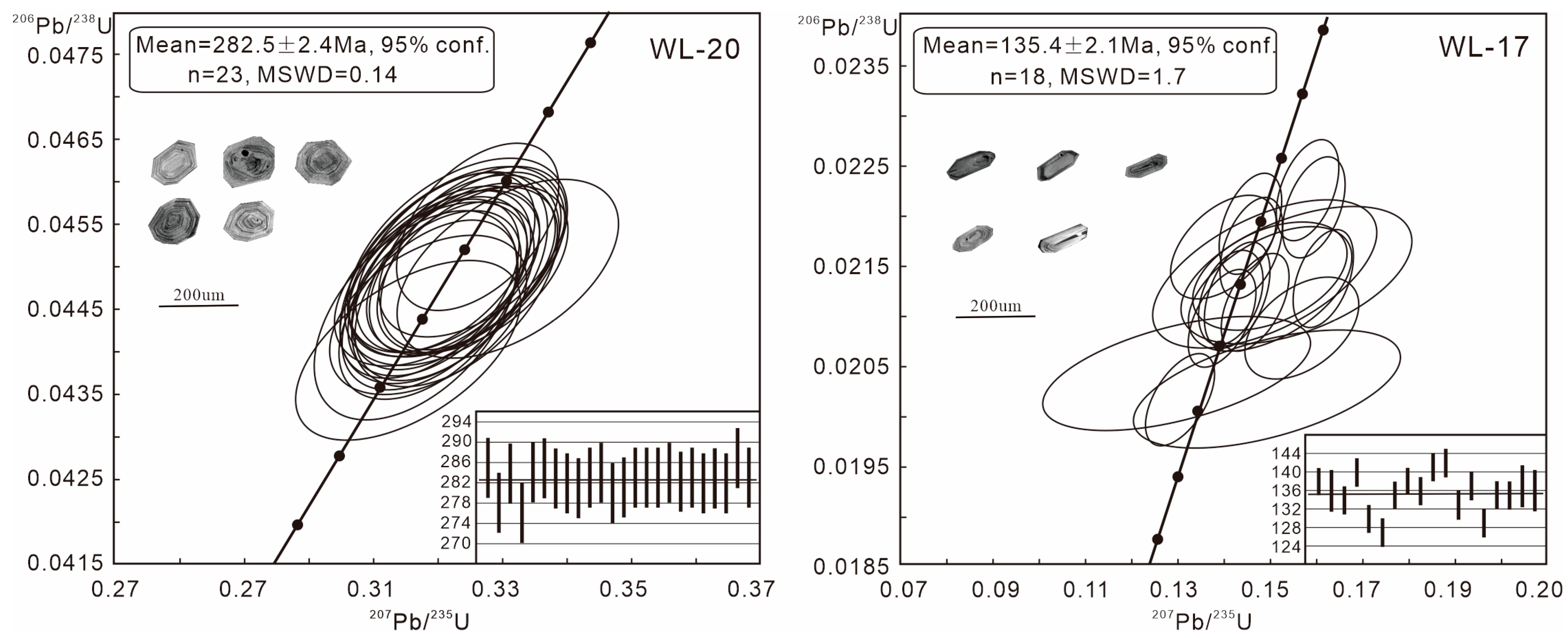
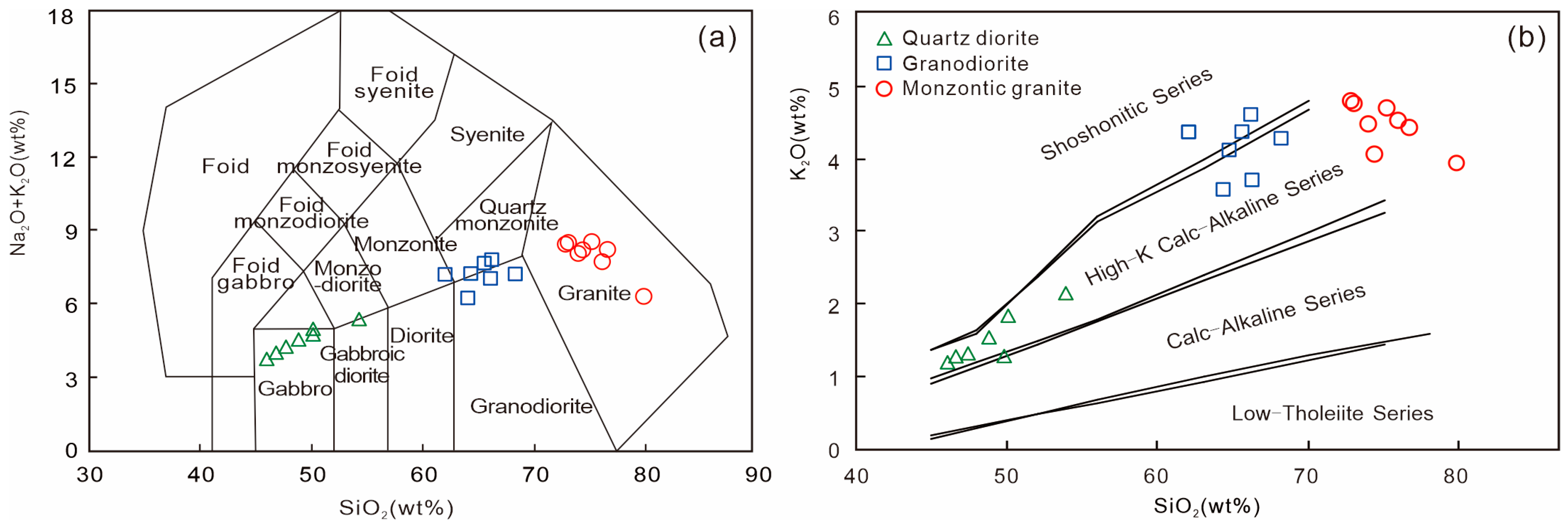

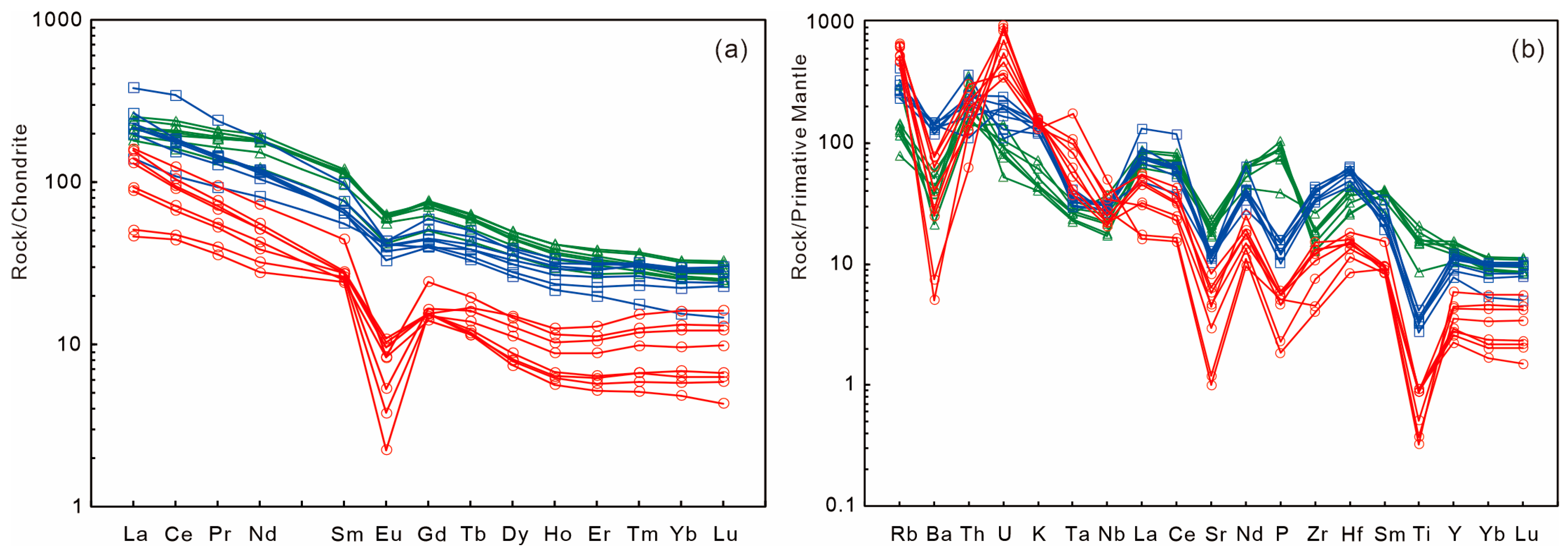
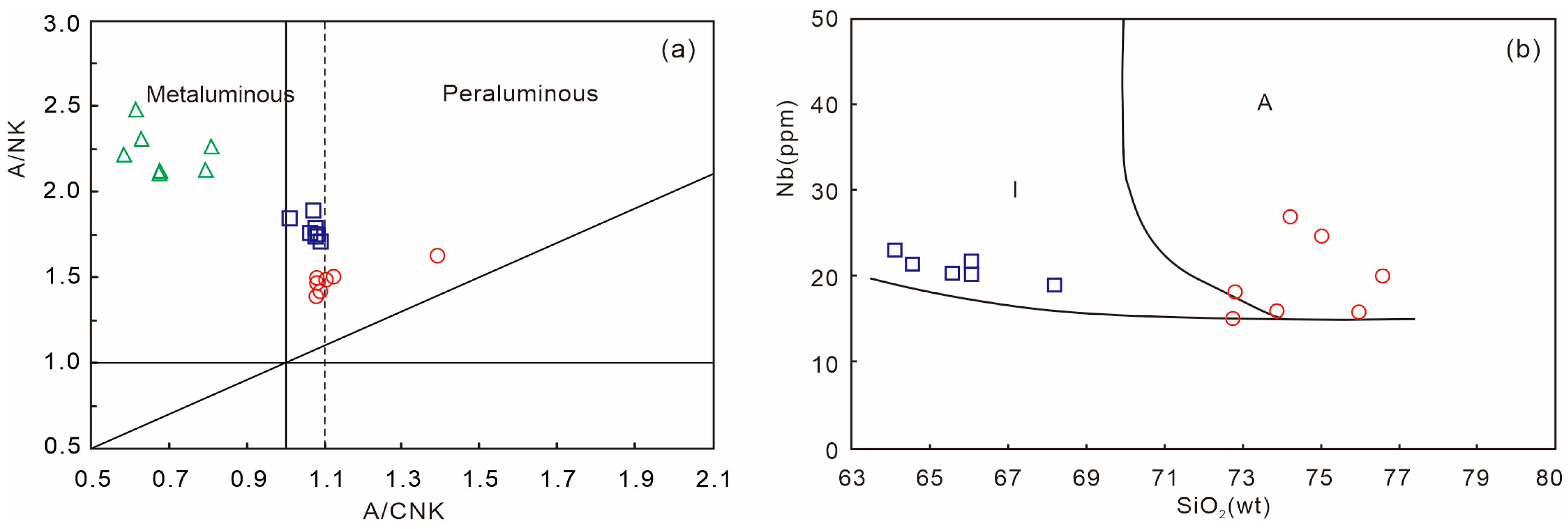


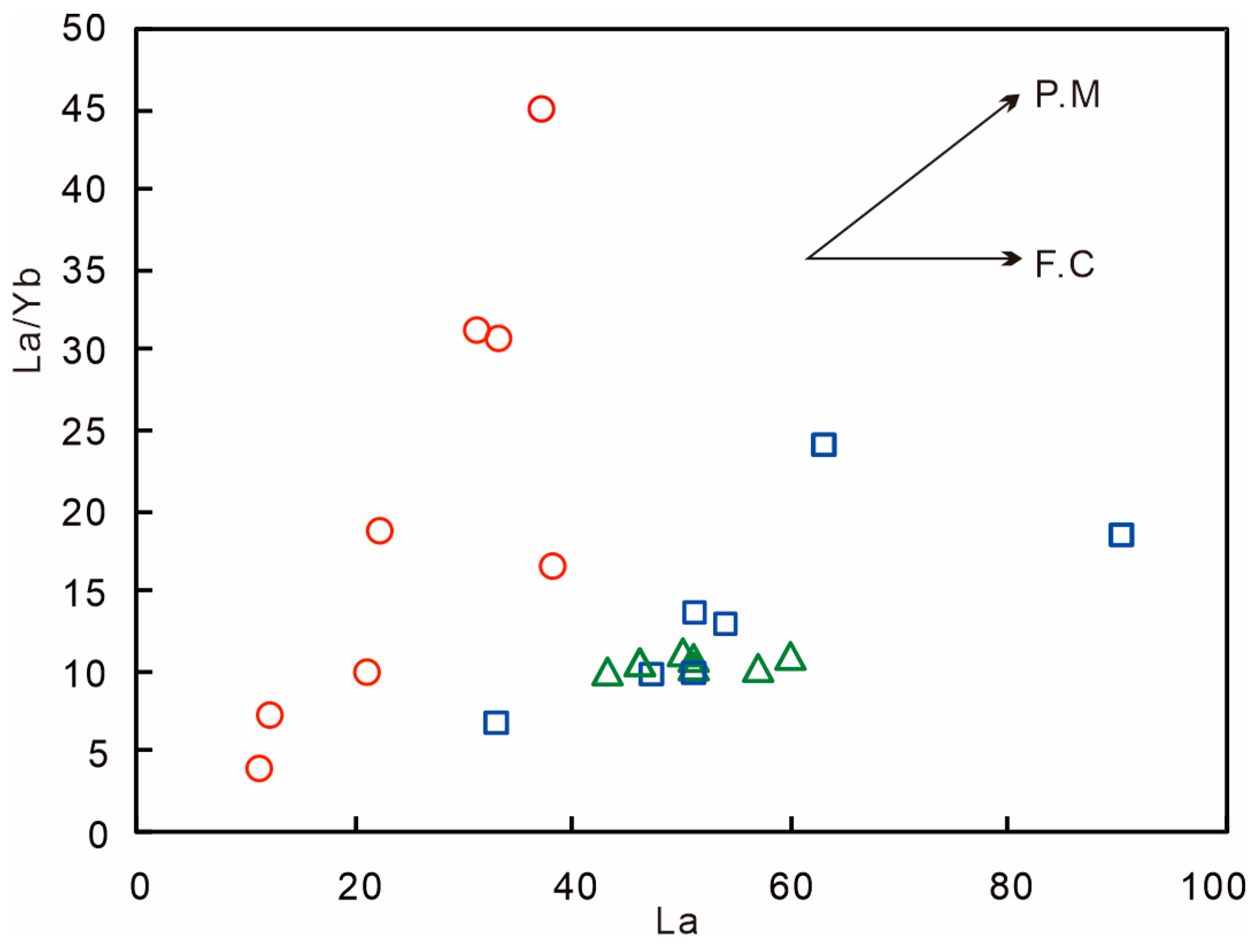
Disclaimer/Publisher’s Note: The statements, opinions and data contained in all publications are solely those of the individual author(s) and contributor(s) and not of MDPI and/or the editor(s). MDPI and/or the editor(s) disclaim responsibility for any injury to people or property resulting from any ideas, methods, instructions or products referred to in the content. |
© 2024 by the authors. Licensee MDPI, Basel, Switzerland. This article is an open access article distributed under the terms and conditions of the Creative Commons Attribution (CC BY) license (https://creativecommons.org/licenses/by/4.0/).
Share and Cite
Wang, J.; Zhang, J.; Liu, Z.; Zhao, Y.; Zhang, F. Geochronological, Geochemical and Pb Isotope Inferences for Genesis of Wulandele Porphyry Molybdenum Deposit, Inner Mongolia, Northeast China. Minerals 2024, 14, 699. https://doi.org/10.3390/min14070699
Wang J, Zhang J, Liu Z, Zhao Y, Zhang F. Geochronological, Geochemical and Pb Isotope Inferences for Genesis of Wulandele Porphyry Molybdenum Deposit, Inner Mongolia, Northeast China. Minerals. 2024; 14(7):699. https://doi.org/10.3390/min14070699
Chicago/Turabian StyleWang, Jianping, Jiexian Zhang, Zhenjiang Liu, Yun Zhao, and Fangfang Zhang. 2024. "Geochronological, Geochemical and Pb Isotope Inferences for Genesis of Wulandele Porphyry Molybdenum Deposit, Inner Mongolia, Northeast China" Minerals 14, no. 7: 699. https://doi.org/10.3390/min14070699







